Top Selling Plug-in Hybrid Electric Crossover Comes To America
Mitsubishi is an almost invisible brand in the United States with slim model choices well within the mainstream of what is on the market. Then surprise, along comes the 2018 Mitsubishi Outlander PHEV GT S-AWC that will make consumers take notice as one of the first affordable plug-in SUVs.
Before we go much further, let’s take a run at what that alphabet soup means.

PHEV = Plug-in Hybrid Electric Vehicle, meaning the car can run on electricity only, but also has a gasoline engine
GT = Gran Tourismo trimline
S-AWC = Super-All Wheel Control. Mitsubishi’s terminology and philosophy for its all-wheel drive system
So, what does this get you? For starters, hopefully a bit of confidence. The Outlander PHEV was, as of January 2018, the world’s best-selling plug-in hybrid crossover. With more than 100,000 sold in Europe 2015-2017, it is one of the Continent’s best-selling plug-ins. Adding the Outlander PHEV to its USA line-up will not only be good for Mitsubishi, but also for consumers.
Drivetrain
The Super All-Wheel Control or S-AWC Outlander PHEV is powered by a series and parallel hybrid drive system. The system’s components are a 2.0-liter, four-cylinder gasoline-powered internal combustion engine (ICE), combined with front and rear 60-kW electric motors. All together, they run through a very smooth-operating single-speed transmission, so there is no CVT adjusting or a torque converter producing noise or vibration. A single-speed transmission with a gasoline engine? Well, the Mitsubishi drivetrain is first an electric vehicle and the ICE is considered a range extender. It’s similar in concept to the Chevrolet Volt system. Melvyn Baustista, product manager for the Outlander, explained that the difference from the Chevrolet technology is that Mitsubishi “has a blended PHEV system with different driving modes. In our system the engine can run the car completely or power the generator to charge the battery.”
Choices, Choices, Choices
The 2018 Mitsubishi Outlander PHEV can be put in “D” and off you go. Or, if being in control is your thing, you can play with a vast array of buttons, paddles and switches. Mitsubishi calls it “multiple driver selectable modes.” Here we go!
There are three computer-selected drive system modes.
- EV is self-explanatory and allows up-to 22 miles of pure electric driving
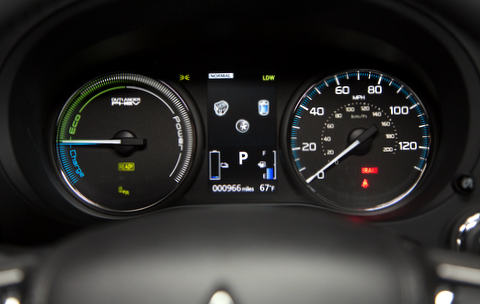
The Mitsu’s gauges keep you informed of what’s happening - Series Hybrid mode combines the twin electric motors and the ICE when the EV battery is low or an extra burst of acceleration is needed.
- Parallel Hybrid mode is the most commonly used where the ICE is the primary power. The twin electric motors kick-in on-demand, such as climbing a hill, and the on-board generator returns excess energy to the battery.
- [Editor’s note: This is Mitsubishi terminology and not exactly aligned with common usage of the terms. In strict usage, a series hybrid system would have an ICE driving the generator and the electric motors powering the wheels at all times. In a parallel system, either the electric motor or the ICE can power the drive wheels. What Mitsubishi has is a sophisticated hybrid of a hybrid system that uses both modes at different times.]
Then, there are four driver–controlled modes.
- EV Priority where the ICE is not running.
- ECO reduces fuel and electricity for the most efficient driving.
- Battery Save conserves the EV battery by placing the Outlander in ICE-only mode.
- Battery Charge will charge the EV battery while driving down the road. You can get an 80-percent charge level in about 40 minutes of running the onboard generator. More on this later.
Then there are two traction modes.
- AWD Auto
- AWD Lock
Then there are five braking regeneration modes.
- Levels B1 – B5, controlled by the left side paddle shifter.
Sound confusing? Mitsubishi admits in future generations a few of those modes will be combined or eliminated. But once you drive the 2018 Outlander PHEV, it really isn’t all that hard to understand which mode to be in for the best fuel economy and traction.
How Far and How Efficient
Combined fuel economy for the electric and gasoline propulsion system, which includes being able to drive 22 miles only on electricity, is rated at 74 MPGe. MPGe is a measurement of how far a car can travel electrically on the same amount of energy as is contained in one gallon of gasoline. Once the electric has been depleted and operating in hybrid mode, the fuel economy is rated at 24 mpg. In 344 miles of 75-percent highway/25-percent city driving, we averaged a combined 41.8 mpg. This is a respectful number for a car weighing in at 4,178 pounds.

The 12.0 kWh lithium-ion (li-ion) battery is charged by plugging into a 120V (Level 1), 240V (Level 2) or a 480V (Level 3 DC fast-charging) outlet, through regenerative braking, or by the ICE. To replenish the li-ion battery’s 22-mile driving range, estimate eight hours for Level 1, 3.5 hours for Level 2 and 25 minutes to an 80-percent charge for Level 3.
The regenerative charging system converts kinetic energy into electric energy and stores it in the battery when applying the brakes or coasting. This process can be viewed on a dash gauge where you can watch the power flow into and out of the battery and engine. The Outlander PHEV has five regeneration levels, controlled by the left side paddle shifter. Each click from zero to five adds more force and thusly more electricity going from the brakes and into the battery. This gives you a near one-pedal driving ability, as long as you apply the hill start assist button when at a stop light. Otherwise, you will begin to creep forward after coming to a full stop.
Driving Experience: On the Road
The 2018 Mitsubishi Outlander PHEV is easy to drive and very quiet. When starting and idling, it reminds you it is mostly an electric vehicle. The smooth ride was unaffected by Southern California’s grooved concrete freeways, but a stiffer suspension would combat body pitch-and-roll. The steering is on the light side, and a heavier feel would not compromise any of the ride attributes and would lead to more road feedback and feel. The Outlander PHEV accelerates smoothly, but not fast. Zero-to-60 in the mid-nine-second range isn’t considered quick.
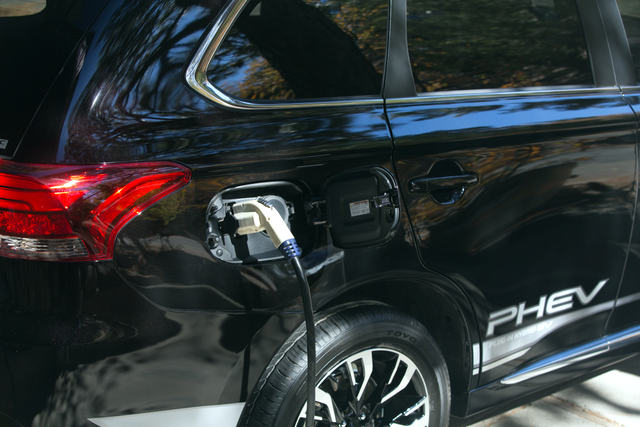
The Outlander PHEV, in the GT S-AWC trim level, comes standard with 18-inch two-tone alloy wheels that were mounted with 225/55R all-season Toyo A24 tires. The best handling was when pushing the AWD Lock button, which delivered flatter cornering and the least amount of body lean. Placing the Outlander PHEV in AWD Lock produces the best offload capability, which is adequate, but certainly not for anything aggressive such as rock climbing. The 7.3-inch ground clearance, with hill start assist, will come in handy just in case you get stuck off the pavement.
Stopping comes from the anti-lock braking system with electronic brake force distribution and brake assist. The 11.6-inch ventilated front and solid disc rear brakes stopped with confidence, but they were touchy. Touchy as in lurching forward and even nose-diving when stopping from high speeds. It is not uncommon for regenerative brakes to be sensitive, but these took some getting used to for proper pressure and modulation.
The Outlander PHEV has three very useful features that help maximize fuel economy and aide in electric running. The first is an onboard, 70 kW generator that charges the EV battery while you are driving. The second is the Battery Save feature that places the existing electric charge in a vault for later use and, lastly, is the EV button. This option holds the car in electric mode for around town and city driving.
Driving Experience: Exterior
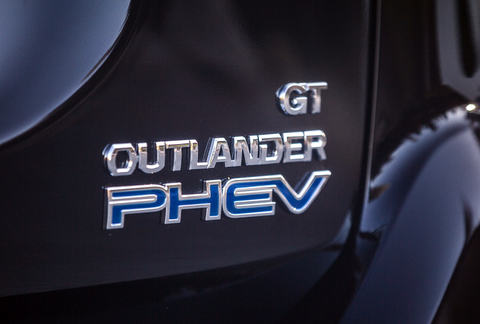
This is an attractive crossover. A couple of my neighbors thought it was a Land Rover, especially from the front elevation. The 2018 Mitsubishi Outlander PHEV features smooth surfaces with soft lines and edges. The curved nose includes wrap-around LED head, running and fog lights, set on the outside edges of a classy bright chrome and smoke chrome grille. The roofline, with chrome rails, has a near-flat roof and a power moonroof, ending with a small spoiler over the rear hatch window and nearly vertical rear end. The LED tail lights are set apart by a chrome accent piece. If you choose not to order the large “PHEV” graphics for the rear passenger doors, the blue and chrome PHEV badges on the lower right side of the lift gate and each front fender will be the only things that differentiate the plug-in Outlander from the gasoline-only model.
Clean Fleet Report’s test Outlander was painted in Ruby Black Pearl, a $295 option. If you like a striking vehicle, then digging not-too-deep in your pocket for this color choice is well worth the investment.
Driving Experience: Interior
Clean Fleet Report was driving the GT trim level Outlander, which came with black leather seating surfaces with red top stitching. The driver and front passenger seats were heated and eight-way power adjustable, but lacked lumbar adjustments. The cockpit design is driver friendly with the gauges, including the hybrid management system, all in easy sight and reach. The heated, leather-wrapped steering wheel contains audio telephone and voice controls. The dual zone automatic climate control system was easy to use and had large temperature knobs for the driver and passenger. One not-so-great thing is the park button is located behind the gear shifter, so you have to reach around the shifter to get at it. This isn’t the first car Clean Fleet Report has reviewed where the button has this placement, but we hope it’s not a trend.
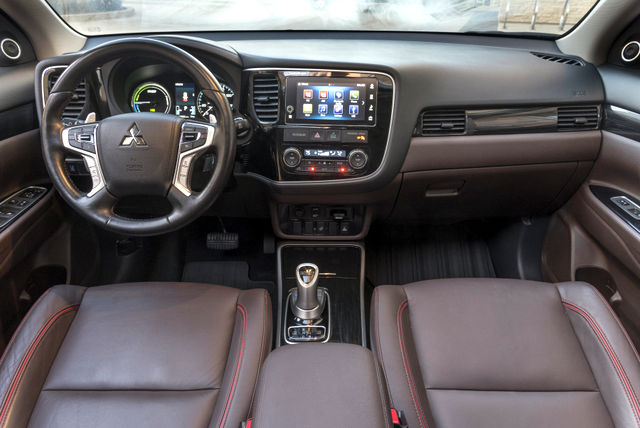
The 2018 Mitsubishi Outlander PHEV infotainment (entertainment and information) comes with voice command navigation through an 7.0-inch high-resolution touchscreen. Excellent sound comes from the Rockford Fosgate premium audio system with nine speakers and a 710-watt amp, delivering SiriusXM/FM/CD/HDAM with MP3 playback capability. The SiriusXM service is included for 90 days. There is an auxiliary audio jack, USB port with iPod connectivity, music streaming via Bluetooth wireless technology and hands-free phone capability. Apps include Apple CarPlay and Android Auto. The only complaint is the radio only had a volume knob and no channel selection knob. Both makes driving easier and safer.
The second row seats three adults with good headroom, but the seat back was too upright. Seat and thigh support were very good though. Other good features worth noting are that the center seatbelt buckle tucks away under the seat back and the rear seat backs recline. For something impressive, the second row folds and tucks away with one of the niftiest systems on any crossover or SUV. The second row also folds 60/40.
Convenience and Safety
Convenience and safety features on our Outlander PHEV included a power lift gate with a rear wiper, cargo tie-down hooks, under floor cargo storage, reading lights front and rear, power windows with front auto up and down, power door locks, multiple USB ports, two 1,500-watt power outlets, folding heated power side mirrors with turn indicators and multiple cup holders.
The Homelink is a nice feature in the auto-dimming rear view mirror, as is the multi-view camera system that provides full exterior viewing. Also, a great feature is Auto Hold, which, when engaged, allows you to remove your foot from the brake pedal. Very handy when in traffic experiencing an annoying number of stoplights.
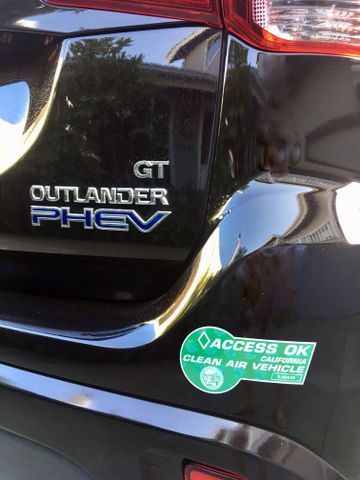
The 2018 Mitsubishi Outlander PHEV is well-equipped with active and passive safety features. There are seven air bags, a tire pressure monitoring system, collapsible steering column, anti-theft alarm and engine immobilizer, rear view camera, blind spot monitoring with rear cross traffic alert and lane change assist. Also included are adaptive cruise control, forward collision mitigation system and the previously mentioned four-wheel disc brakes with ABS.
Pricing and Warranties
The 2018 Mitsubishi Outlander PHEV has a base MSRP of $34,595. Clean Fleet Report’s GT S-AWD model had a base MSRP of $40,295. With $970 in options, the total price, excluding the $940 destination charge, was $41,285.
The 2018 Highlander Hybrid comes with these warranties:
- New Vehicle Five years/100,000 miles
- Powertrain 10 years/100,000 miles
- PHEV Components 10 years/100,000 miles
- Anti-perforation Seven years/Unlimited miles
- Roadside Assistance Five years/Unlimited miles
Observations: 2018 Mitsubishi Outlander PHEV GT S-AWD
Clean Fleet Report values vehicles that offer multiple benefits, which in the case of the Outlander PHEV includes interior space, ample storage capacity, good fuel economy, contemporary looks and a competitive base price. The interior is very comfortable, especially for long trips and outings, and the cargo capacity makes hauling luggage on those long trips easy. We even noted how pleasing it was to hear a resounding thud when closing the doors.

The selection of plug-in hybrid electric crossovers is small, but more are coming to market each year. This lack of competition presents Mitsubishi with a good opportunity to impress consumers with this proven vehicle. Many people shy away from a car in its first year on the market, but with the sales success Mitsubishi has had worldwide with the Outlander PHEV, there is no reason to wait for the next model year.
Before visiting your local Mitsubishi dealer, call and make an appointment with a factory-trained and certified hybrid specialist. The Outlander PHEV is Mitsubishi’s most technologically advanced vehicle, so a trained associate will walk you through all the systems and features. Once you get the details and information, you just may be driving home in an Outlander PHEV.
Whatever you end up buying, Happy Driving!
Related Stories You Might Enjoy—Plug-in Hybrid Crossovers (Here & Coming)
News: Subaru Crosstrek PHEV To Arrive By Year’s End
Interview: Ford Electrifies—Sedans Need Not Apply
News: Buick’s Electric Car Explosion
News: Nissan IMx Electric CUV
Road Test: 2018 Kia Niro Plug-in Hybrid (John’s views)
Road Test: 2018 Kia Niro Plug-in Hybrid (Steve’s view)
Analysis: Lack of Model Choice Hampers Plug-in Sales
Disclosure:
Clean Fleet Report is loaned free test vehicles from automakers to evaluate, typically for a week at a time. Our road tests are based on this one-week drive of a new vehicle. Because of this we don’t address issues such as long-term reliability or total cost of ownership. In addition, we are often invited to manufacturer events highlighting new vehicles or technology. As part of these events we may be offered free transportation, lodging or meals. We do our best to present our unvarnished evaluations of vehicles and news irrespective of these inducements.
Our focus is on vehicles that offer the best fuel economy in their class, which leads us to emphasize electric cars, plug-in hybrids, hybrids and diesels. We also feature those efficient gas-powered vehicles that are among the top mpg vehicles in their class. In addition, we aim to offer reviews and news on advanced technology and the alternative fuel vehicle market. We welcome any feedback from vehicle owners and are dedicated to providing a forum for alternative viewpoints. Please let us know your views at publisher@cleanfleetreport.com.


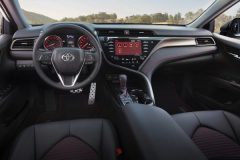
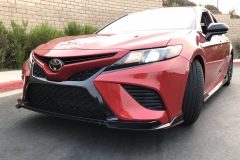
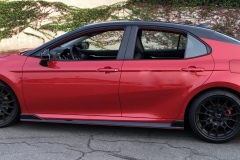
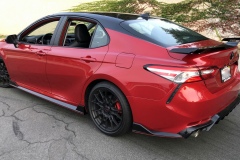

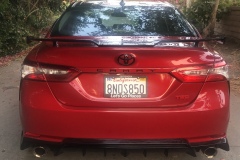
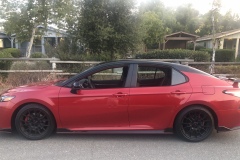
10 thoughts on “Road Test: 2018 Mitsubishi Outlander PHEV GT S-AWC”